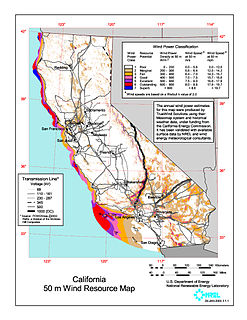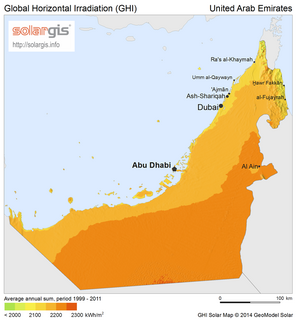Masdar,(Arabic:مصدر), also known as the Abu Dhabi Future Energy Company, is a UAE-government owned renewable energy company based in Abu Dhabi, United Arab Emirates. Masdar is a subsidiary of Mubadala Development Company and was founded by the UAE government in 2006. It is guided by The Abu Dhabi Economic Vision 2030, a program that drives new sources of income for the Emirate and strengthens its knowledge-based economic sectors.

The London Array is a 175-turbine 630 MW Round 2 offshore wind farm located 20 kilometres (12 mi) off the Kent coast in the outer Thames Estuary in the United Kingdom. It was the largest offshore wind farm in the world until Walney Extension reached full production in September 2018.

Wind power in California had initiative and early development during Governor Jerry Brown's first two terms in the late 1970s and early 1980s. The state's wind power capacity has grown by nearly 350% since 2001, when it was less than 1,700 MW. In 2016, wind energy supplied about 6.9% of California's total electricity needs, or enough to power more than 1.3 million households. Most of California's wind generation is found in the Tehachapi area of Kern County, California, with some large projects in Solano, Contra Costa and Riverside counties as well. California is among the states with the largest amount of installed wind power capacity. In recent years, California has lagged behind other states when it comes to the installation of wind power. It was ranked 4th overall for wind power electrical generation at the end of 2016 behind Texas, Iowa, and Oklahoma. As of 2019, California had 5,973 megawatts (MW) of wind power generating capacity installed.
The electricity sector in New Zealand uses mainly renewable energy; such as hydropower, geothermal power and increasingly wind energy. As of 2019, 82% of electricity is generated from renewable sources, making New Zealand one of the countries with the lowest carbon dioxide emissions from electricity generation. Electricity demand grew by an average of 2.1% per year from 1974 to 2010 but decreased by 1.2% from 2010 to 2013.
There are a number of wind power projects in the state of Maine, totaling more than 900 megawatts (MW) in capacity and responsible for 13.85% of in-state electricity production in 2017. In 2019, Maine had more wind capacity than the other five New England states combined, at 923 MW.

The energy sector in Hawaii has rapidly adopted solar power due to the high costs of electricity, and good solar resources, and has one of the highest per capita rates of solar power in the United States. Hawaii's imported energy costs, mostly for imported petroleum and coal, are three to four times higher than the mainland, so Hawaii has motivation to become one of the highest users of solar energy. Hawaii was the first state in the United States to reach grid parity for photovoltaics. Its tropical location provides abundant ambient energy.
Enviromena is a clean energy technology company in Europe. It has installed more than 17,000 solar systems. The company has over 425 MW of solar power plants under operation and a further 200 MW under construction.

Energy in Malta describes energy production, consumption and import in Malta. Malta has no domestic resource of fossil fuels and no gas distribution network, and relies overwhelmingly on imports of fossil fuels and electricity to cover its energy needs. Since 2015, the Malta–Sicily interconnector allows Malta to be connected to the European power grid and import a significant share of its electricity.

Energy in Jordan describes energy and electricity production, consumption and import in Jordan. Jordan is among the highest in the world in dependency on foreign energy sources, with 96% of the country's energy needs coming from imported oil and natural gas from neighboring Middle Eastern countries. This complete reliance on foreign oil imports consumes a significant amount of Jordan's GDP. This led the country to plan investments of $15 billion in renewable and nuclear energy. To further address these problems, the National Energy Strategy for 2007-2020 was created which projects to boost reliance on domestic energy sources from 4 per cent to 40 per cent by the end of the decade.

Wind power in Hawaii has the potential to provide all of the electricity generation in the electricity sector in Hawaii. The 132 commercial wind turbines in the state have a total capacity of 236 MW. In 2015, wind turbines produced 6.4% of Hawaii's electricity. In 2012, Hawaii generated 367 million kWh from wind power.

Renewable energy in Taiwan contributed to 8.7% of national electricity generation as of end of 2013. The total installed capacity of renewable energy in Taiwan by the end of 2013 was 3.76 GW. As of 2020, the Taiwan government aims for a renewable share of 20% by 2025, with coal and gas providing the other 80%.
Stockyard Hill Wind Farm is a wind farm project in Victoria (Australia). As of June 2020, 1 of a planned 149 turbines was operational and connected to the grid. When it is fully commissioned, it is expected to produce up to 530MW, which would be Australia's largest wind farm.

Solar power in the United Arab Emirates has the potential to provide most of the country's electricity demand. While being a major oil producing country, the United Arab Emirates (UAE) has taken steps to introduce solar power on a large scale. However, solar power still accounts for a small share of energy production in the country. The country was the 6th top carbon dioxide emitter per capita in the world in 2009, with 40.31 tonnes, but is planning to generate half of its electrical energy by 2050 from solar and nuclear sources, targeting 44% renewables, 38% gas, 12% coal, and 6% nuclear energy sources.

Block Island Wind Farm is the first commercial offshore wind farm in the United States, located 3.8 miles (6.1 km) from Block Island, Rhode Island in the Atlantic Ocean. The five-turbine, 30 MW project was developed by Deepwater Wind. Construction began in 2015 and in late summer 2016 five Alstom Haliade 150-6-MW turbines were erected. Operations were launched in December 2016. It is the largest project using wind power in Rhode Island.

Georgia had a total primary energy supply (TPES) of 4.793 Mtoe in 2016. Electricity consumption was 11.5 TWh in 2016. Electricity production was 11.6 TWh, of which 81% from hydroelectricity and 19% from natural gas.
Romainville Island is an artificial island in Seychelles, lying 2 km from the capital Victoria.
Port Island is an artificial island in Seychelles, lying 2 km from the capital Victoria.

Wind power is a major industry in Taiwan. Taiwan has abundant wind resources however a lack of space on land means that most major developments are offshore. As of February 2020, there were 361 installed onshore turbines and 22 offshore turbines in operation with the total installed capacity of 845.2 MW.
Energy in the Faroe Islands is produced primarily from fossil fuels, with further contributions from hydro and wind power. Oil products are the main energy source, mainly consumed by fishing vessels and sea transport. Electricity is produced by oil, hydropower and wind farms, mainly by SEV, which is owned by all the municipalities of the Faroe Islands. The Faroe Islands are not connected by power lines with continental Europe, and thus the archipelago cannot import or export electricity.











